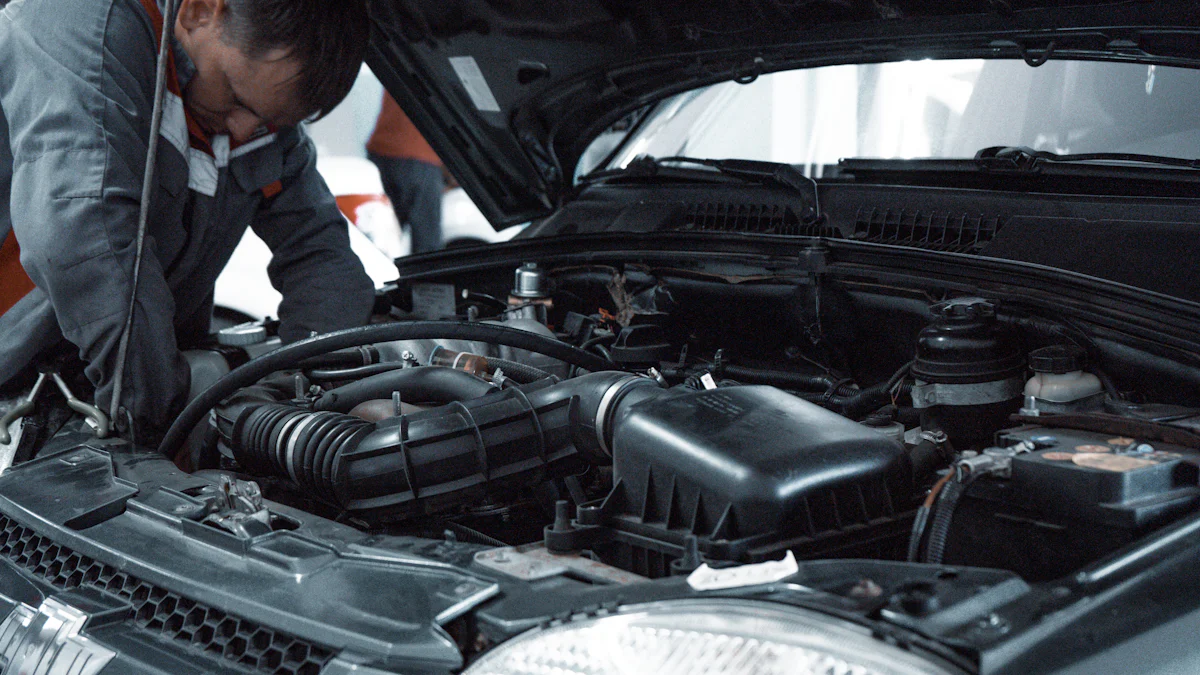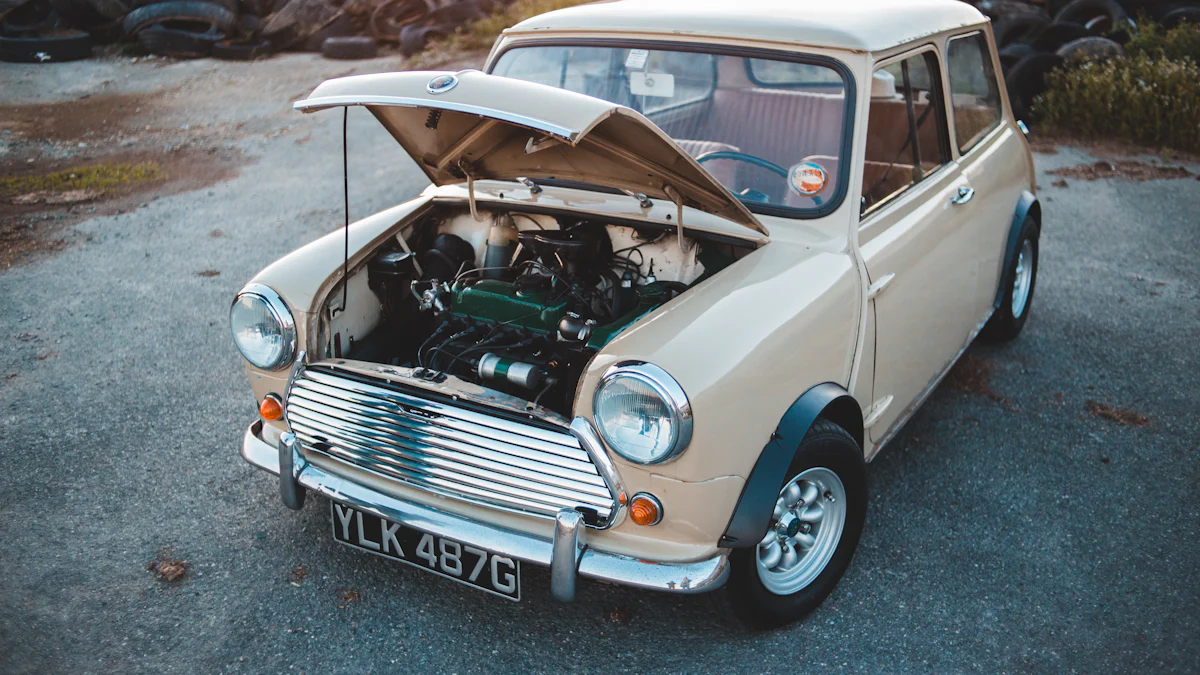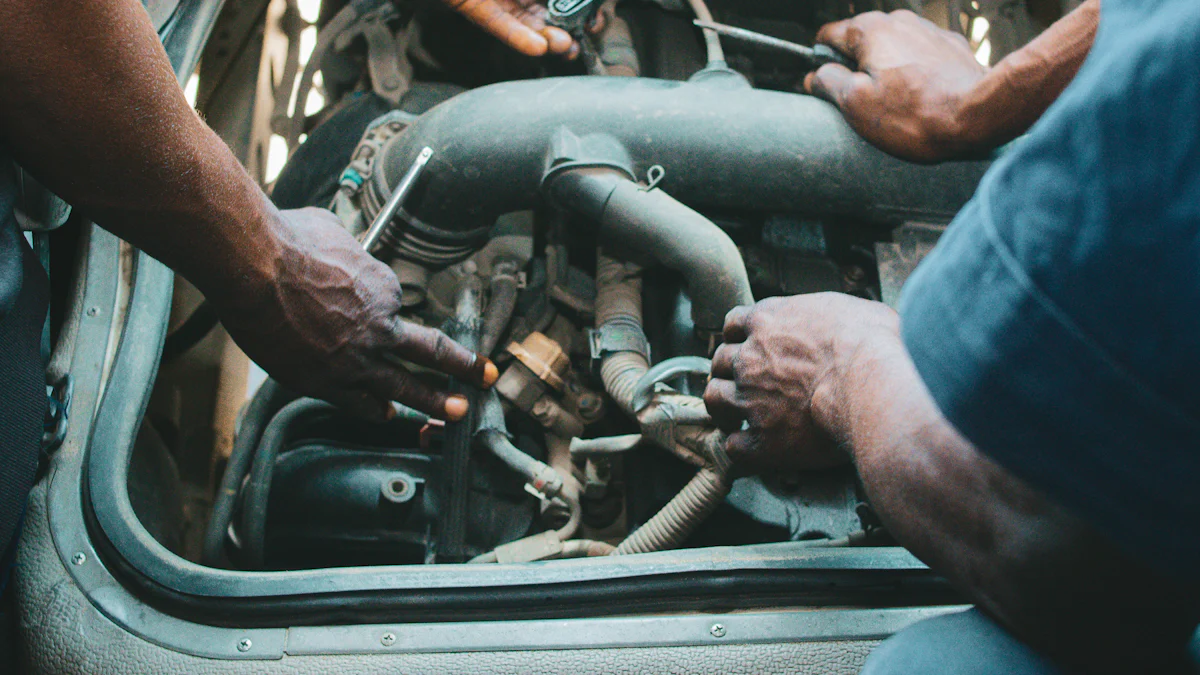
In the world of Mini Cooper S maintenance, comprehending the harmonic balancer is like interpreting the heartbeat of a car. This essential component ensures the smooth operation of the engine by reducing vibrations and maintaining balance. When this mini cooper s harmonic balancer malfunctions, it communicates through distinct signs such as unsettling engine tremors, mysterious noises, and the ominous glow of a check engine light. Exploring these indicators reveals a realm where timely action can protect your cherished Mini from expensive repairs and potential breakdowns. Let’s embark on a journey to uncover the mysteries of the engine harmonic balancer in your Mini Cooper S.
Tip 1: Recognize the Symptoms

Common Signs
Engine Vibrations
When your MINI starts to exhibit engine vibrations, it’s like the car is doing a little dance of its own. These subtle shakes can be a sign that something is amiss under the hood. It’s as if your MINI is trying to tell you, “Hey, something’s not quite right here!”
Unusual Noises
Imagine driving your MINI and suddenly hearing unusual noises coming from the engine. It’s like the car is whispering secrets to you, but these whispers are anything but comforting. These sounds can range from subtle murmurs to loud clatters, each one indicating a potential issue that needs attention.
Check Engine Light
Ah, the dreaded check engine light – a signal that sends shivers down any car owner’s spine. When this light illuminates in your MINI, it’s like a silent alarm going off, warning you of possible trouble ahead. Ignoring it could lead to more significant problems down the road.
Importance of Early Detection
Preventing Further Damage
Early detection of issues related to the engine harmonic balancer in your MINI is crucial for preventing further damage. It’s like catching a cold before it turns into a full-blown flu – addressing the problem early can save you from more extensive repairs and costly bills.
Cost Implications
Addressing harmonic balancer issues early on not only saves your MINI from potential harm but also saves you from hefty repair bills. By taking action promptly, you’re not just fixing a current problem; you’re investing in the longevity and performance of your beloved MINI.
Tip 2: Choose the Right Replacement
When it comes to selecting a replacement for your MINI‘s harmonic balancer, the decision between OEM and aftermarket options can be quite perplexing. Each choice presents its own set of advantages and disadvantages that are worth considering before making a final decision.
OEM vs. Aftermarket
Pros and Cons
- OEM Balancers: These genuine MINI Harmonic Balancers are designed specifically for your vehicle, ensuring a precise fit and optimal performance. While they may come at a higher price point, their quality and compatibility are unmatched.
- Aftermarket Options: On the other hand, aftermarket Harmonic Crankshaft Dampers offer a more cost-effective solution without compromising on quality. They often meet or even exceed OEM specifications, providing excellent value for money.
Werkwell Harmonic Balancers
When exploring aftermarket options for your MINI Cooper S, one standout choice is the range of Werkwell Harmonic Balancers. These products boast an array of features that cater to the diverse needs of car owners looking for reliable replacements.
Product Features
- *BMP Design harmonic vibration damper with FluidGel*: This innovative design eliminates the need to remove the motor during installation, simplifying the replacement process significantly. The use of FluidGel technology ensures smooth operation and enhanced durability.
- Genuine MINI Harmonic Balancers: Known for their robust construction and longevity, these balancers are engineered to withstand the rigors of daily driving. Their seamless integration with your vehicle guarantees optimal performance and peace of mind.
- *Aftermarket Harmonic Crankshaft Damper*: If cost-effectiveness is a priority, this option offers a budget-friendly alternative without compromising on quality. With a design that meets OEM standards while offering unique enhancements, it provides an excellent balance between affordability and reliability.
Customer Reviews
Here’s what some satisfied customers have to say about their experience with Werkwell Harmonic Balancers:
“The Werkwell Harmonic Balancer I installed in my MINI exceeded my expectations. Not only did it resolve my engine vibration issues, but it also improved overall engine performance.” – John D.
“Switching to an aftermarket harmonic balancer from Werkwell was one of the best decisions I made for my MINI. The product fit perfectly and has been running smoothly ever since.” – Sarah L.
Tip 3: Prepare for Replacement
Necessary Tools
Basic Tools
- Socket wrench set
- Torque wrench
- Screwdriver set
- Pliers
- Hammer
Specialized Tools
- Harmonic balancer puller tool
- Crankshaft pulley holding tool
- Serpentine belt tool kit
Safety Precautions
Protective Gear
- Safety goggles to shield your eyes from debris and fluids.
- Heavy-duty gloves for a secure grip and protection against sharp edges.
- Coveralls or old clothing to keep your attire clean and shielded from grease.
Safe Work Environment
“Safety first, they say! Ensuring a safe work environment is paramount when embarking on the journey of harmonic balancer replacement.”
- Well-lit Workspace: Adequate lighting is essential for clarity and precision during the replacement process.
- Stable Vehicle Position: Park your MINI on a level surface with the parking brake engaged to prevent any unexpected movement.
- Cool Engine: Always start the replacement process with a cool engine to avoid burns or injuries from hot components.
- Fire Extinguisher: While rare, it’s wise to have a fire extinguisher nearby in case of emergencies.
- Ventilation: Working in a well-ventilated area helps dissipate fumes and ensures fresh air circulation throughout the process.
- First Aid Kit: Accidents can happen, so having a first aid kit handy is a proactive safety measure.
Remember, each step you take towards ensuring safety not only protects you but also contributes to a smooth and successful harmonic balancer replacement experience!
Tip 4: Follow a Step-by-Step Guide

Removing the Old Balancer
Disconnecting Components
- Begin by disconnecting the negative terminal of the battery to ensure safety during the replacement process.
- Loosen and remove the drive belt from the harmonic balancer pulley using an appropriate tool.
- Unbolt and remove any components obstructing access to the balancer, such as engine covers or brackets.
- Carefully detach the crankshaft position sensor connector to prevent damage during balancer removal.
- Inspect for any additional connections or fasteners securing the old balancer in place and remove them accordingly.
Using a Puller Tool
- Position the harmonic balancer puller tool securely onto the balancer, ensuring proper alignment for effective removal.
- Gradually tighten the puller tool’s center bolt to create tension and gently pry the old balancer off the crankshaft.
- Exercise caution and patience while applying pressure to avoid damaging surrounding components or causing injury.
- Once loosened, carefully slide off the old balancer, taking care not to drop it or cause any unnecessary strain on nearby parts.
- Thoroughly clean the mounting surface of any debris or residue before proceeding with installing the new harmonic balancer.
Installing the New Balancer
Aligning the Balancer
- Prioritize aligning key slots or marks on both the new harmonic balancer and crankshaft to ensure proper orientation.
- Gently slide the new balancer into position, making sure it sits flush against the crankshaft hub without misalignment.
- Rotate and adjust as needed to guarantee a snug fit that aligns perfectly with other engine components.
Securing the Balancer
- Begin by hand-threading bolts or fasteners into place to secure the harmonic balancer firmly on the crankshaft.
- Utilize a torque wrench set to manufacturer specifications for tightening bolts evenly in a crisscross pattern.
- Confirm that all connections are properly secured and aligned before reattaching any previously removed components like engine covers or brackets.
By following this step-by-step guide meticulously, Mini Cooper S owners can navigate through harmonic balancer replacement with confidence and precision, ensuring optimal engine performance and longevity for their beloved vehicles!
Tip 5: Post-Replacement Checks
Inspecting the Installation
Ensuring Proper Fit
Upon completing the meticulous process of replacing the harmonic balancer in your Mini Cooper S, a crucial step awaits – inspecting the installation to guarantee a seamless fit. Just like finding the perfect puzzle piece to complete the picture, ensuring that the new balancer snugly aligns with the crankshaft hub is paramount. This step not only validates the precision of your replacement endeavor but also sets the stage for optimal engine performance and longevity.
Checking for Leaks
As you embark on this post-replacement journey, akin to a detective searching for clues, it’s essential to check for any telltale signs of leaks. A vigilant eye can detect even the slightest hint of fluid seepage, indicating potential issues that require immediate attention. By meticulously examining your Mini Cooper S for leaks post-harmonic balancer replacement, you safeguard against future complications and ensure a smooth driving experience ahead.
Test Driving the Vehicle
Monitoring Performance
With the harmonic balancer securely in place and all checks completed, it’s time to put your Mini Cooper S to the test through a thorough test drive. As you navigate through familiar streets or embark on new adventures, pay close attention to how your vehicle responds. Monitor its performance like a seasoned conductor leading an orchestra – every sound, vibration, and movement providing valuable insights into the success of your replacement endeavor.
Listening for Noises
During your test drive escapade, attune your ears to listen keenly for any unusual noises emanating from your Mini Cooper S. Just as a skilled musician detects even the faintest discordant note in a symphony, be alert to any sounds that deviate from the harmonious hum of a well-functioning engine. Whether it’s a subtle rattle or an unexpected clunk, each noise serves as a melody guiding you towards identifying potential issues post-harmonic balancer replacement.
In this phase of post-replacement checks, vigilance is key as you navigate through inspecting installations, checking for leaks, test driving your vehicle, and listening intently for any irregularities. By embracing these tasks with diligence and precision, Mini Cooper S owners can ensure that their beloved vehicles continue to operate smoothly and harmoniously on every journey they undertake!
Recapping the journey through the realm of Mini Cooper S harmonic balancer replacement unveils a tapestry of essential insights. From recognizing early symptoms to selecting the right replacement, each tip serves as a beacon guiding owners towards optimal engine health. Timely action isn’t just a suggestion; it’s a shield against potential breakdowns and costly repairs. Remember, when in doubt, consulting professionals can provide clarity and expertise to navigate any roadblocks smoothly.
Post time: Jun-04-2024



